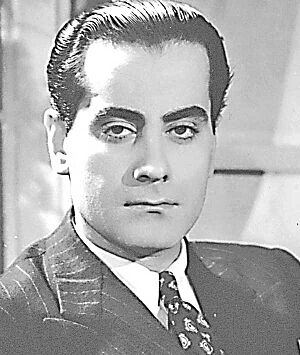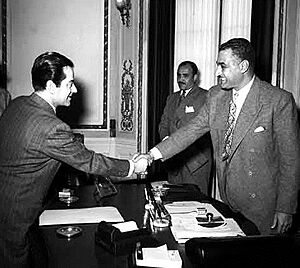Farid al-Atrash facts for kids
Quick facts for kids
Farid Al-Atrash
|
|
|---|---|
 |
|
| Background information | |
| Native name |
فريد فهد فرحان إسماعيل الأطرش
|
| Birth name | Farid Fahd Farhan Ismail Al-Atrash |
| Born | October 19 1910 Ottoman Syria, Ottoman Empire |
| Origin | As-Suwayda, Syria |
| Died | December 26, 1974 (aged 64) Beirut, Lebanon |
| Genres | Arabic, Egyptian classical, instrumental |
| Occupation(s) | Singer, actor, composer, instrumentalist |
| Instruments | Vocals, oud |
| Years active | 1930s–1974 |
| Associated acts | Asmahan |
Farid al-Atrash (Arabic: فريد الأطرش; October 19, 1910 – December 26, 1974) was a very famous Syrian-Egyptian singer, composer, and actor. He is also known as Farid El-Atrache. When he was only nine years old, he moved to Egypt with his mother and siblings. There, he learned music from many respected teachers.
Farid al-Atrash had a very successful career that lasted over 40 years. He recorded 500 songs and acted in 31 movies. People sometimes called him "malek al-oud," which means "king of the oud." He is one of the most important musicians in Arab music from the 20th century.
Contents
Farid al-Atrash's Early Life
Farid al-Atrash was born in 1910 in Al-Qurayya, a town in southern Syria. His family, the al-Atrash family, were Druze princes. They were known for fighting against the French army that occupied their land. His father was Syrian, and his mother was Lebanese.
When Farid was a young child, his family moved to Egypt to escape the French occupation. Later, the Egyptian government made them citizens. Farid's mother loved to sing and play the oud, a stringed instrument. This inspired Farid's interest in music from a very young age.
As a child and young adult, Farid often sang at school events. He studied music at a music conservatory in Egypt. He also became a student of the famous Egyptian composer Riad Al Sunbati. In the 1930s, Farid started his professional singing career. He worked for private radio stations in Egypt. Later, he was hired by the national radio station as an oud player, and then as a singer. His sister, Asmahan, was also a talented singer. For a while, they worked together. In 1941, they starred in their first successful movie, Intisar a l-Shabab (The Triumph of Youth). Farid wrote all the music for this film himself.
His Family and Sister Asmahan
Farid, his sister Amal (known as Asmahan), and their brother Fouad were part of the Druze family of their parents, Princess Alia and Prince Fahd al-Atrash. Asmahan also showed great musical talent when she was a teenager. She became a very popular female singer and movie star in the late 1930s and early 1940s.
Farid is more famous than Asmahan because her career ended early when she died in an accident in 1944. At first, Farid was less known than his sister. But as he grew older and developed his own style, Farid became famous on his own. Even today, when people in Arab music or culture say "Farid," they usually mean Farid al-Atrash.
Farid al-Atrash's Musical Journey
Farid al-Atrash had a long and exciting music career that lasted for 40 years. He wrote many different kinds of songs. He was highly respected as a composer, singer, and instrumentalist. Farid believed that even though some of his music had Western influences, he always stayed true to traditional Arab music. Most of his songs were about romantic love, but he also wrote patriotic and religious songs.
One special thing about Farid al-Atrash was his voice. At the start of his career, his voice was high and soft. Over time, it became wider and deeper.
In many of his songs and almost all his concerts, Farid would sing a mawal. This is a slow, improvised vocal part based on a few lines of poetry. These improvisations could sometimes last up to 15 minutes. His fans loved his mawals. Some of his most famous songs include "Rabeeh" (Spring), "Awal Hamsa" (First Whisper), "Hekayat Gharami" (Story of My Love), and "Ya Zahratan Fi Khayali" (Flower of My Imagination).
Farid al-Atrash's Film Career
Farid al-Atrash starred in 31 Egyptian musical films between 1941 and 1974. His last movie, Nagham Fi Hayati (Songs in My Life), was released after he passed away. All his films, except for the last two, were in black and white. They included comedies, dramas, or a mix of both.
Farid composed all the songs in his movies. This included songs sung by other actors and instrumental pieces, often for belly dance scenes. His earlier films usually had about ten songs, but later films averaged about five songs each. Some of Farid al-Atrash's well-known movies are Intisar al-Shabab (The Triumph of Youth, 1941), Lahn al-Kholoud ("Eternal Tune", 1952), and Resala min Imraa Maghoola (Letter from an Unknown Woman, 1962).
Farid al-Atrash's Personal Life

Farid went through a difficult time when his sister and fellow performer, Asmahan, passed away. He found comfort in his friendship with the dancer Samia Gamal. He even risked his own money to produce a movie with her in 1947 called Habib al-'Oumr ("The Love of My Life"). This movie was a huge success. After that, they made Afrita Hanem ("Madame la Diablesse," 1949). After five films together, their close working relationship ended. Farid continued to work with other film stars in many successful movies. He often played the role of a sad singer who was looking for love. He even chose his character's name to be "Wahid," which means "lonely."
Farid al-Atrash chose to focus on his art rather than getting married. In his films, audiences often remembered his leading ladies and his beautiful songs more than the actual stories.

Before the Egyptian Revolution of 1952, Farid al-Atrash became friends with Queen Nariman, who was married to King Farouk I. Their friendship continued even after the Queen's divorce and the revolution. However, the former queen's family did not approve of Farid. This separation made Farid very sad and led to health problems that continued until his death.
As Farid al-Atrash got older, he thought about marriage again. He proposed to Egyptian singer Shadia, but at the last minute, he changed his mind. His health was not good, and he worried he would leave her a young widow. He often explored this idea in his romantic movies. He was also engaged to Salwa al-Qudsi at the end of his life. Some people say he remained single his whole life, but he might have had a very short, informal marriage.
Farid al-Atrash's Death
Farid al-Atrash had heart problems for the last 30 years of his life. In his final years, he became thinner, and his singing voice became a bit rougher. Even though he was struggling with his health, he kept making movies and performing in concerts until he passed away.
On December 24, 1974, doctors told Farid al-Atrash he could go home in two days. They knew he did not like being in the hospital. However, on December 26, 1974, Farid al-Atrash died in Beirut, Lebanon, at Al Hayek hospital. He had just arrived from London. Farid al-Atrash is buried in Cairo, Egypt, next to his sister and brother.
Farid al-Atrash's Legacy
Farid al-Atrash composed songs for many top Arab singers. These included his own sister, Asmahan, as well as Wadih El-Safi, Shadia, Warda, and Sabah. He is widely considered one of the four greatest figures in Egyptian and Arabic music. The others are Abdel Halim Hafez, Mohammed Abdel Wahab, and Oum Kalthoum. The famous Egyptian guitarist Omar Khorshid even recorded an album of Farid al-Atrash's songs as a tribute.
His music was produced by the Voice of Lebanon label. The entire collection of his music was later bought by Mazzika Group in the early 2000s.
One of his songs could be heard on the radio in the 2005 video game Grand Theft Auto: Liberty City Stories.
On October 19, 2020, Google celebrated his 110th birthday with a special Google Doodle on their homepage.
Farid al-Atrash's Filmography
- Intisar al-Shabab (1941)
- Ahlam el chabab (1943)
- Shahr el asal (1946)
- Ma akdarshi (1946)
- Gamal wa Dalal (1946)
- Bolbol effendi (1946)
- Habib al omr (1947)
- Ahebbak inta (1949)
- Afrita hanem (1949)
- Akher kedba (1950)
- Taa la salim (1951)
- Ma takulshi la hada (1952)
- Lahn al khouloud (1952)
- Ayza atgawwez (1952)
- Lahn hubi (1954)
- Risalat Gharam (1954)
- Ahdil Hawa (1955)
- Oussit Hobi (1955)
- Izhay ansak (1956)
- Wadda'tu hubbak (1957)
- Inta habibi (1957)
- Maleesh Gheirak (1958)
- Min agl Hobbi (1960)
- Shatie el hub (1961)
- Yomun bala ghaden (1962)
- Ressalah min emraa maghoula (1962)
- Hikayet el omr kulluh (1965)
- El-Khouroug min el-guana (1967)
- Al-Hob al-kabir (1969)
- Zaman Ya Hob (1973)
- Nagham fi Hayati (1974)
See also
 In Spanish: Farid al-Atrash para niños
In Spanish: Farid al-Atrash para niños


